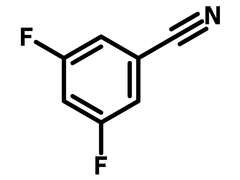3,5-Difluorobenzonitrile
CAS Number 64248-63-1
Chemistry Building Blocks, Fluorinated Building Blocks, Materials, MonomersA difluorinated benzonitrile building block
Used as electron acceptors in OLEDs and catalysts in organometallic chemistry
Specifications | MSDS | Literature and Reviews
3,5-Difluorobenzonitrile (CAS number 64248-63-1) is a benzonitrile derivatives with two fluorine substituents at the meta-positions. 3,5-Difluorobenzonitrile is applied as an electron acceptor unit in axially chiral excimers/exciplexes showing cyan luminescence. The exciplexes also display thermally activated delayed fluorescence (TADF), which are promising for OLEDs. The chromophore size of 3,5-difluorobenzonitrole can be expended with carbazole derivatives through nucleophilic aromatic substitution. The synthesized 3,5-difluorobenzonitrole-carbazol emitters have photoluminescence quantum yield (PLQY) of 29% and external quantum efficiency (EQE) of 5.3%.
3,5-Difluorobenzonitrile has also found its use in organometallic chemistry. 3,5-Difluorobenzonitrile assists the conversion of catalytically inactive (phosphine)2Ni to (phosphine)Ni(alkene), a desired catalyst intermediate in cross coupling-reactions.
Multiple functional groups
For facile synthesis
Fluorinated benzonitrile building block
For drug discovery, organic synthesis and OLEDs research
Worldwide shipping
Quick and reliable shipping
High purity
>98% High purity
General Information
| CAS Number | 64248-63-1 |
| Chemical Formula | C7H3F2N |
| Full Name | 3,5-Difluorobenzonitrile |
| Molecular Weight | 139.10 g/mol |
| Synonyms | 5-Cyano-1,3-difluorobenzene |
| Classification / Family | Fluorinated building block, Benzonitrile derivatives, Dyes, OLEDs, Ligands, Catalysts |
Chemical Structure

Product Details
| Purity | 98% |
| Melting Point | Tm = 84 °C – 86 °C |
| Appearance | White powder |
MSDS Documentation
 3,5-Difluorobenzonitrile MSDS Sheet
3,5-Difluorobenzonitrile MSDS Sheet
Literature and Reviews
- Structural studies of perfluoroaryldiselenadiazolyl radicals: insights into dithiadiazolyl chemistry, R. Melen et al., Inorg. Chem., 55, 11747–1175(2016); DOI: 10.1021/acs.inorgchem.6b01771.
- Comprehensive study of the reactions between chelating phosphines and Ni(cod)2, A. Clevenger et al., Organometallics, 37, 19, 3259–3268(2018); DOI: 10.1021/acs.organomet.8b00438.
- Luminescent chiral exciplexes with sky-blue and green circularly polarized-thermally activated delayed fluorescence, P. Sumsalee et al., Chem. Eur. J., 27, 16505(2021); DOI: 10.1002/chem.202102765.
